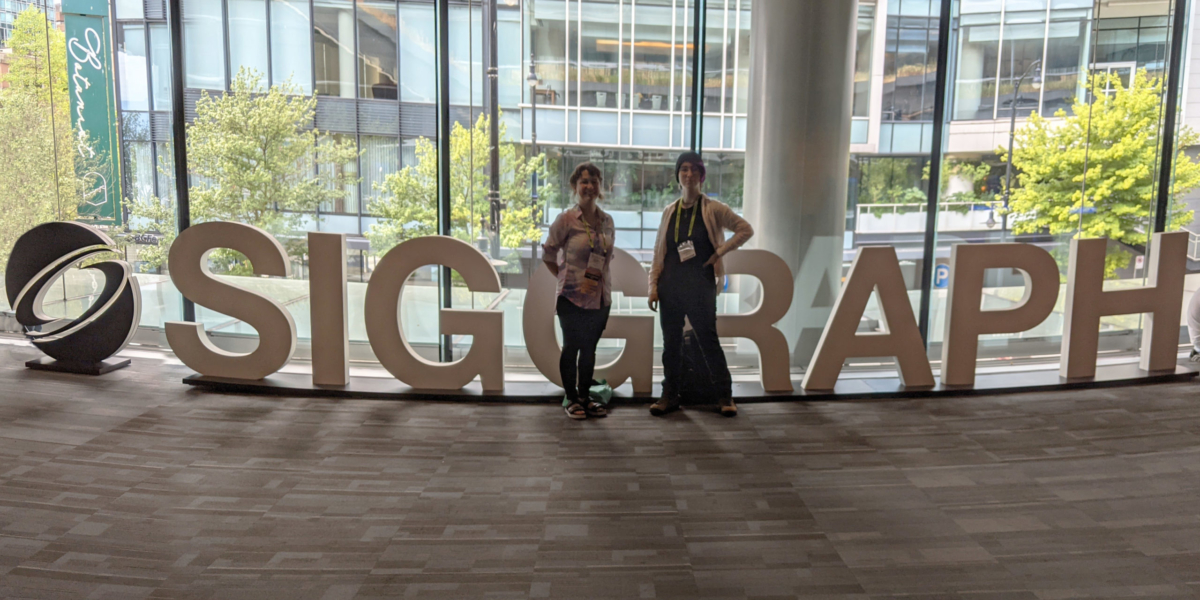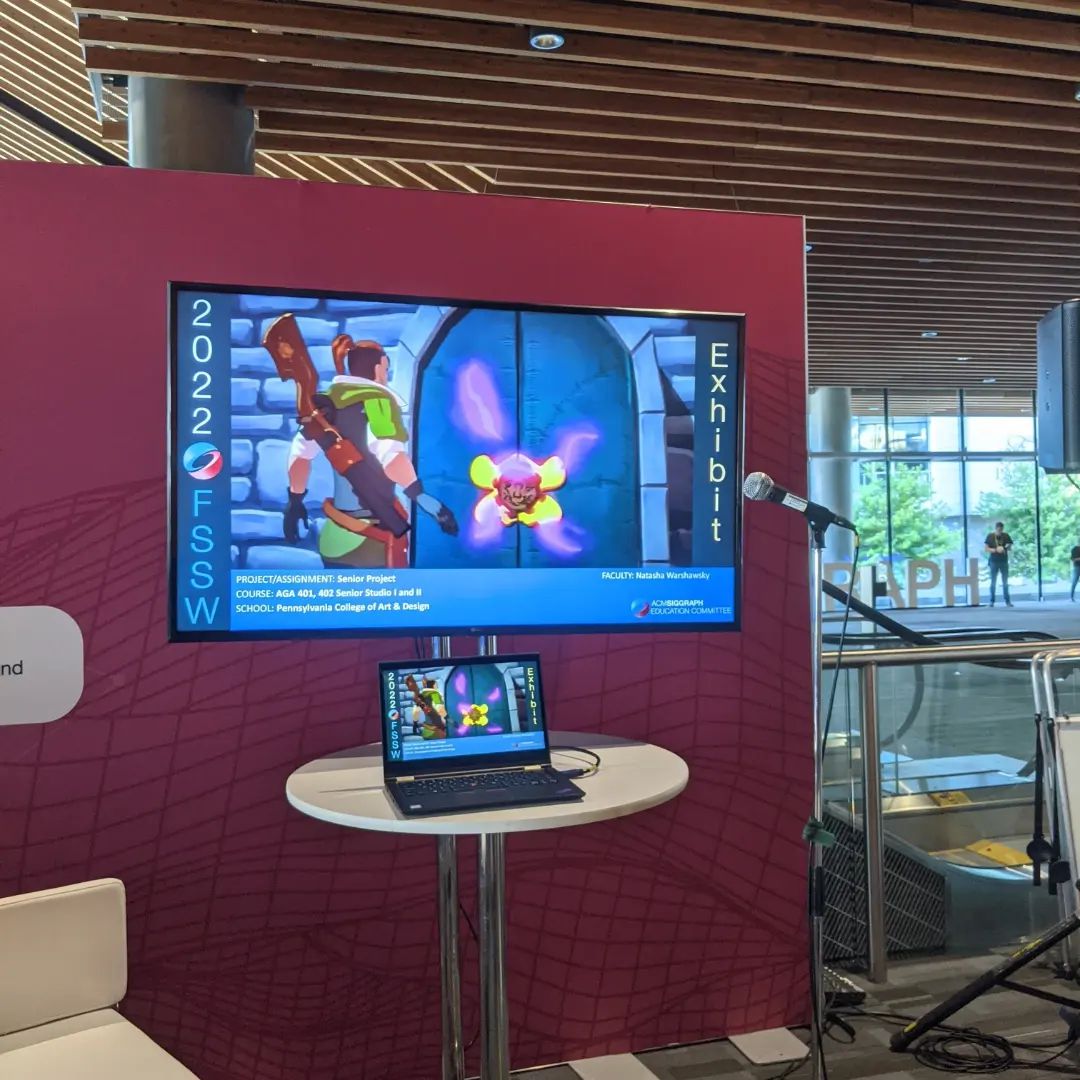
Faculty Grant Series: Profs. Warshawsky and Cochran explore SIGGRAPH conference
Monday, October 3rd, 2022
Attendance at the national SIGGRAPH conference gives attendees an inside look not only at trend-setting computer graphics and interactive techniques, but also at developments that are so early-stage that they haven’t even had a chance to yet become trends.
The summer event, say Profs. Natasha Warshawsky (Chair, Animation & Game Art) and Ellie Cochran (Adjunct, Graphic Design), was an amazing opportunity to connect with other professionals. And, they add, it also was a chance to solidify a place in the PCA&D classroom for new developments in the computer graphics and interactive fields. Warshawsky was the recipient of a PCA&D Educator Professional Development Grant to attend SIGGRAPH 2022. Cochran ’19, Graphic Design, won a Faculty Research and Development Grant which allowed her to attend that same event.
How did these grants, and SIGGRAPH 2022, impact what they’ll be sharing in the classroom?
Natasha Warshawsky

Prof. Natasha Warshawsky’s display at SIGGRAPH 2022 featured student work. Photo courtesy Natasha Warshawsky.
Ellie Cochran
What inspired you to use the grant to attend SIGGRAPH?
Ellie Cochran: I was inspired because it represents the gestalt of computer graphics, human-computer interaction, digital design and art, and media production. I believe that this synthesis of different fields is a vital step toward human-centered XR design.
I’m fascinated by visionaries like Susan Kare and Dieter Rams, who applied human-centered design thinking and clear sensory communication to complex technologies in order to make them accessible, attractive, and fun (!) for as many people as possible.
Today we are in the midst of yet another personal technology revolution: Many of us already have “digital twins” which we use to interact with online virtual “spaces” such as social media. The idea of making these online spaces fully immersive and 3D isn’t a new one, but designers of the last few decades didn’t have high-powered computers in their pockets or strapped to their bodies. Many of these devices are capable of 3D scanning, and many, many more are capable of acting as an augmented or virtual reality viewport.
However, in order for any new creative technology to gain relevance, it has to have that human-centered design approach that makes it *fun* for artists to create with and *easy* for viewers to experience.
What did you hope to gain from SIGGRAPH as a first-time attendee?
EC: In such fast-paced fields as computer art and digital design, it can be difficult to stay up to date with the latest research and technical information. Since mixed-reality design often involves communication via multiple sensory channels as well as usage of novel technologies, every new paper can represent a major workflow change.
By attending SIGGRAPH, I hoped to better understand human perception and applied design thinking in the augmented and virtual reality “metaverse” space, and return to my students and my studio with the latest design strategies and information to engage the next generation of designers.
It was also a great opportunity to network with other design professionals and educators in this space, and view some really incredible artwork which combined existing and novel technologies in new ways to create new types of human/computer interactions and to have a chat with the artists behind the works to better understand their processes and technologies.
What was the experience like?
EC: Absolutely overwhelming in the best way possible. I never got more than about 5 hours of sleep at a time, but the constant flow of novel information was incredibly stimulating — I just recently finished transcribing all my notes!
Being able to attend SIGGRAPH with someone who was already familiar with the conference and knew some attendees was indispensable in helping me navigate the space. Thanks, Natasha!
Most of my time was taken up by presentations and lectures so I didn’t do as much talking to strangers as I had hoped, but I did manage to get in some conversations with new friends about platforms and strategies which I wouldn’t have otherwise considered. Ultimately, being surrounded by other people fascinated by the intersection of design and technology was incredible and provided a cool opportunity to discuss still-nascent artistic possibilities.
How do you see what you learned impacting your classroom as well as your day-to-day work?
EC: One of the difficulties in teaching design for extended reality is that designers really need to use XR themselves in order to understand its impact on a user and how to design for it. The required financial investment in XR technology is one reason why students (and professionals!) find themselves unable to break into this new field. However, the tools for rapidly prototyping mixed/virtual reality experiences are becoming incredibly accessible. Designers today can draw a paper sketch, scan it with their phone, and instantly have a 360-degree virtual reality interface prototype that they can look around inside of. They can iterate on a concept at the speed of pencil on paper, as opposed to having to build full-scale test applications just to try out a new visual concept.
As an instructor, I’m now empowered to teach XR design theory and give prototyping assignments which my students can then include in their portfolios as interactive virtual-reality demos without having to teach the code or technological processes required to create their own app from scratch or use expensive full-scale VR hardware for testing and iteration.
This lower barrier to entry also makes the design conversation more accessible, leading to increasingly diverse perspectives and voices all working together to find the most effective solution for a given design challenge. This is necessary because design for extended reality often involves many emotional, sensory, and body ability considerations which may be overlooked by individuals with more privilege.
In my personal work, which currently focuses on creating “synesthetic” multi-modal experiences in non-synesthetes, having a better understanding of multi-sensory perception will inform work which more effectively engages people’s existing associations between different perceptual fields.
